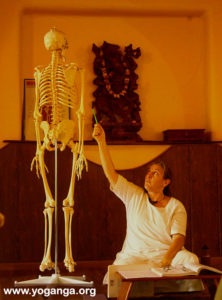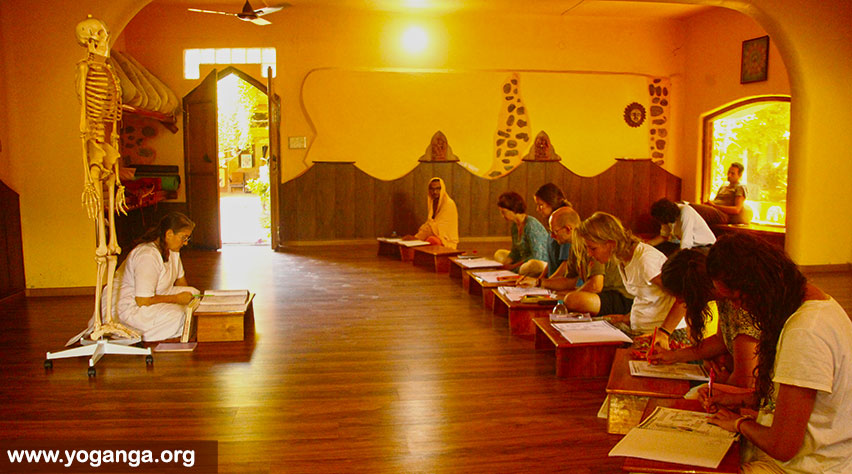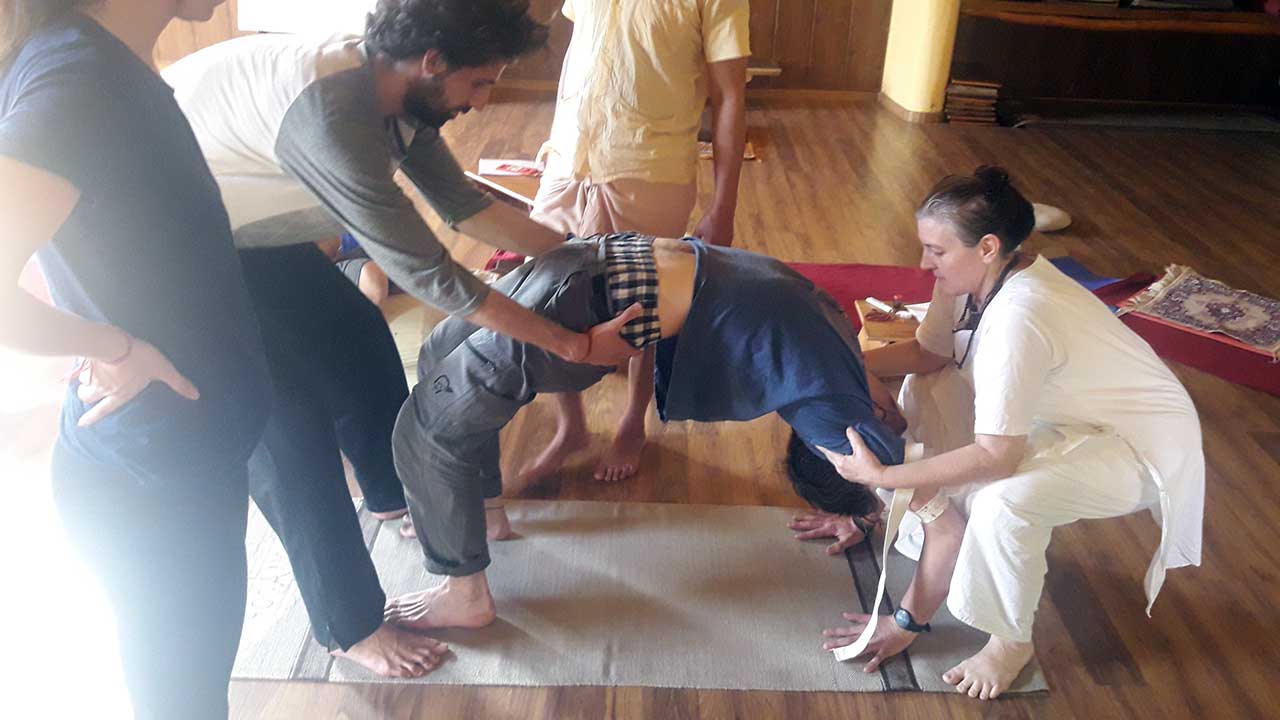Aside from your time on the mat, through lectures, discussions and essay writing, you will not only discover the path of yoga. You will also discover its destination (the goal of yoga), who have been, are and may become your various guides (teachers and gurus) along the way.
Through understanding your own journey, you will be able to have a greater understanding of the various types of students you may encounter in your classes. And gain insights into how to adjust each session accordingly to individual students. Ultimately you will open and empty (purify) your self enough to receive all that your various guides (teachers and masters) may have to offer you.
Shatkarma (six cleansing kriyas): approximately 1 hour, 6 days a week, during the first month. To prepare for the remaining practice in our sapta sadhana (seven limbed yoga system) six cleansing kriyas, some which the participant can incorporate into their daily practice, others to be done on a seasonal basis, are done to purify the physical body. Starting the month with the half version of shankprakshalana ending with the full version, with days in between learning mūlashodhana (rectal cleaning, also called “Ganesh Kriya”); antar dhauti (internal cleansing: varisara, vatsara, vahnisara dhauti); danta dhauti including: danta mūl (teeth), jihva mūl (tongue), netra sodhan (eyes), karnarandra (ears) and kapalrandhra (palate); hrid dhauti (vaman/kunjal); neti (jal & sutra); nauli; kapalbhati: vatakarma kapalbhati (air cleansing), vyutkarma kapalbhati (sinus cleansing); shītkarma kapalbhati (mucus cleansing); and trātak.
Asana: approximately 2 hours, 6 days a week, guided classes during all three months. Done according to the moon cycle: starting with the day after the new moon, with eight asanas added every two days, until the series expands to reach 56 total asanas by the day before the full moon, then eliminating eight asanas every two days until the day before the following new moon, like the waxing / waning of the moon. Learning surya namaskar as well as 56 various asanas in three styles (each month a distinct style): Rājas (holding each asana for 3-5 breaths), Tamas (holding each āsana with inhale/exhale retention), Satva (holding each asana for much longer duration, working with the breath to go deeper into the pose). New Moon / Amavāsya and Full Moon / Purnima are days off. Sundays are teaching-practice days.
Mudra: topics covering various techniques interspersed within asana and prānayama sessions during all three months. Mudras are gestures or attitudes, which Yogis have experienced to be used as short cuts to connect one’s gross prānic flow with the universal or cosmic force. These higher practices can lead towards healing oneself as well as awakening the prānas, chakras and kundalini.
Pratyahara: topics covering various techniques interspersed within āsana and prānayama sessions during all three months.
Pranayam: approximately 1 hour, 6 days a week, guided classes during all three months covering the following practices – abdominal breathing, diaphragmatic breathing, thoracic breathing, full yogic breathing, nadi shodhana, anulom vilom, bhastrika, surya bheda, sitkari, sitali, ujjayi, and brahmari.
Sukshma Vyayām (Subtle Pranic Exercises): approximately 1 hour, 6 days a week, during the second month. Combining prānayama with isolated movements focusing on specific joints and / or energy centers.
Dhyana (Meditation): two separate approximately 1/2 hour sessions for self practice (one in the morning, one in the evening, each by the dhuni before aarti followed by vedic chanting), 7 days a week, during all three months. Aside from which in conjunction with other class sessions such as asana, prānayama, sukshma vyayām and yantra painting, where focus on the breath can lead one to a meditative state, we will also cover various concentration/meditation techniques such as yoga nidra, mantra japa, and laughing meditation.
Therapeutic Yoga: approximately 1 ½ hours, 6 days a week, guided classes during the third month, where students will learn a variety of asana series to practice or teach according their or their students particular health conditions (such as lower back pain, asthma, arthritis, diabeties, heart problems, menstruation and digestion issues etc.) Building upon the knowledge gained about the body in the Anatomy, Physiology and Auyrveda classes, in this section the participant will gain a greater understanding of which practices that keeps the body healthy, in conjunction with how various asanas affect the different physiological systems in the body.
 Anatomy, Physiology and Ayurveda will be covered during the first and second months, as well as referred to continuously during the Alignment and Observation (Biomechanics) sessions throughout the course and Therapeutic Yoga sessions in the third month.
Anatomy, Physiology and Ayurveda will be covered during the first and second months, as well as referred to continuously during the Alignment and Observation (Biomechanics) sessions throughout the course and Therapeutic Yoga sessions in the third month.
During the first month we will cover the basics of Anatomy & Physiology and move on to Ayurveda in the second month, application of this understanding to be used towards keeping the physical body both safe and healthy through yoga. How various asanas affect the specific systems of the body will be covered in more detail in the Therapeutic Yoga Course in the third month.
Ayurveda: Understanding of ayurvedic concepts will help us deepen the practice of yoga and compose diet and lifestyle that will suit our individual requirements. Each Participant will undergo an individual Ayurvedic Consultation with Dr. Alaknanda Puri, in which she will help you understand your own body’s constitution, current dominant dosha and how to manage your own balance and health through various prescribed herbs and treatments accordingly. This course section will also include practical sessions such as medicinal preparations, application of treatments, as well as ayurvedic cooking.

Daily throughout the first month we will break down the creation, retention and dissolution of each of the 56 asanas in our YogAnga series, starting with Surya Namaskar (not as a mere warm up exercise but as an expression of gratitude and devotion). Keeping in mind our five principles that make up a steady and comfortable pose: Breath, Sight, Contact, Alignment, and Vision, we will develop the basic skills to read people’s bodies, see the processes that a student performs in an asana (biomechanics, weight distribution, engagement of muscles, points of stability, working with energy lines). Iyenger Alignment methods with props are also taught.

We will begin by teaching asanas in pairs, polishing your instruction, observation and adjustment skills, then each student will teach a set of asanas to a small group, and then for a larger class.
We will analyze the most important elements of teaching yoga, from postural diagnosis of new students to sequencing of classes and specialized teaching according to individual health conditions. This block will also include a set of practical lessons and self-practice classes to refine the skill of teaching yoga.
Description
Through out the entire three months, the following theoretical lecture sessions will cover the philosophical history of yoga and it’s development through the analysis of some of the most important scriptures. Shruti (listening to the original sanskrit), specific translation of the most important words in the texts, commentary in order to make each concept relatable in our daily lives, as well as opportunities for Q&A, will provide students a greater understanding of main goals of yoga and how to maintain a lifestyle (as prescribed by the ancient Rishis) in order to achieve such goals. Connecting our yoga practice to its roots as well as giving it a philosophical context will make our practice more meaningful and provide us better depth of understanding with which to evaluate our progress on the path.
Learning Objectives:
Your three months with us, will emerge itself as a transformational journey, where each month through lectures, discussions and essay writing, you will discover not only the path of yoga, it’s destination (the goal of yoga), who have been, are and may become your various guides (teachers and gurus) along the way, but most importantly where you are on this path and how to proceed towards your goal. Through understanding your own journey you will be able to have a greater understanding of the various types of students you may encounter in your classes and how to adjust each session accordingly, as well as open and empty (purify) your self enough to receive all that your various guides (teachers and masters) may have to offer you.